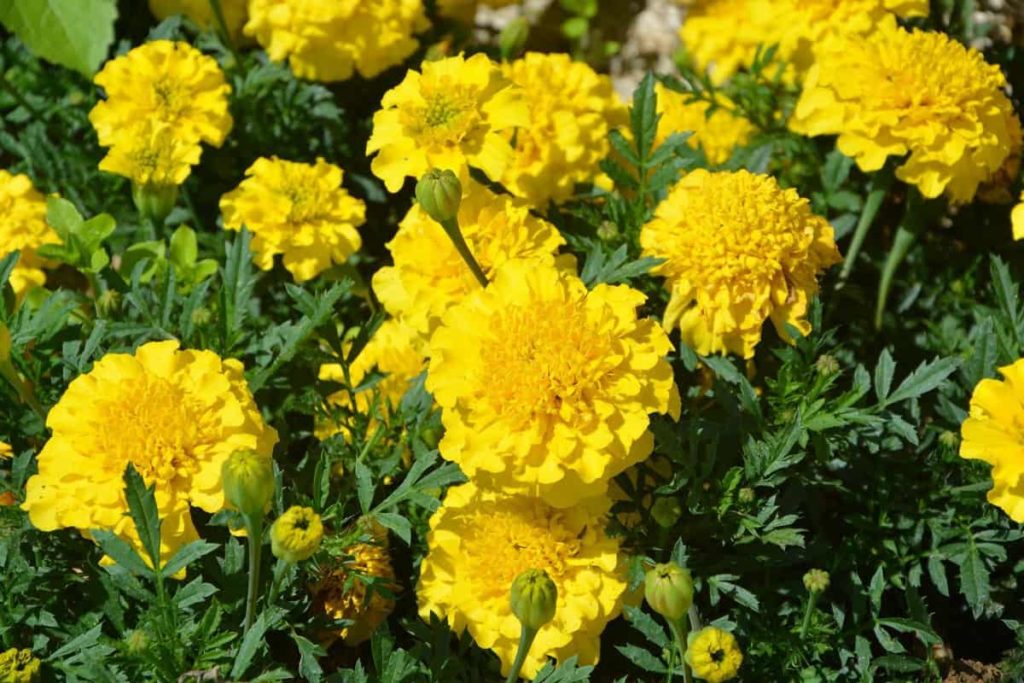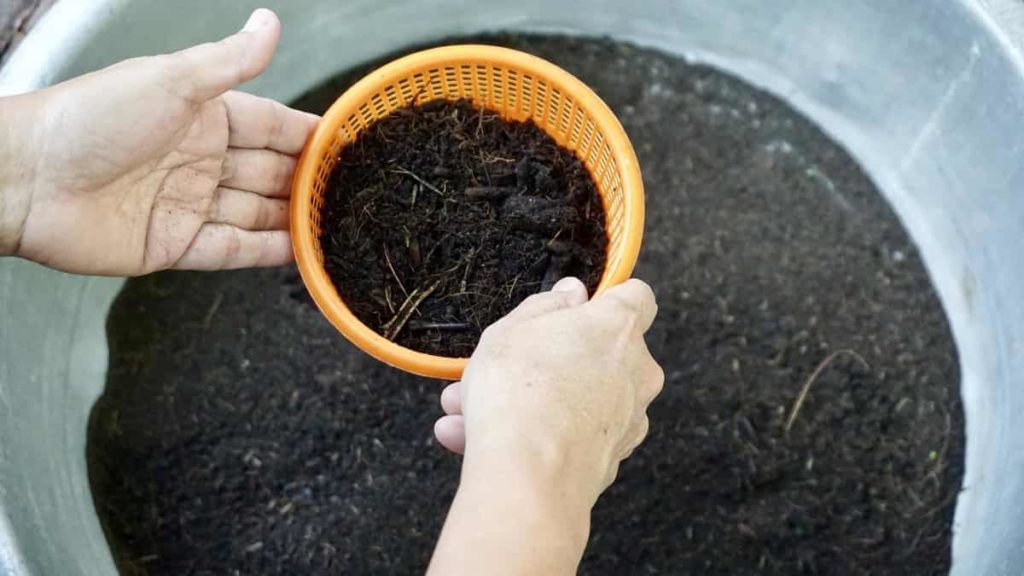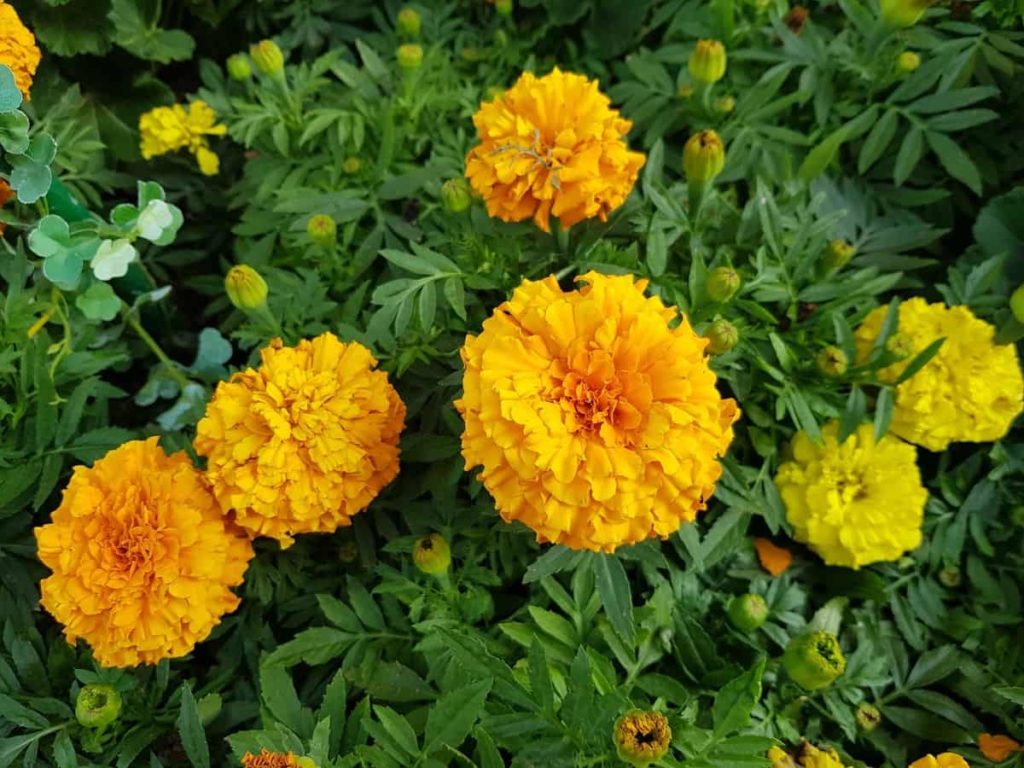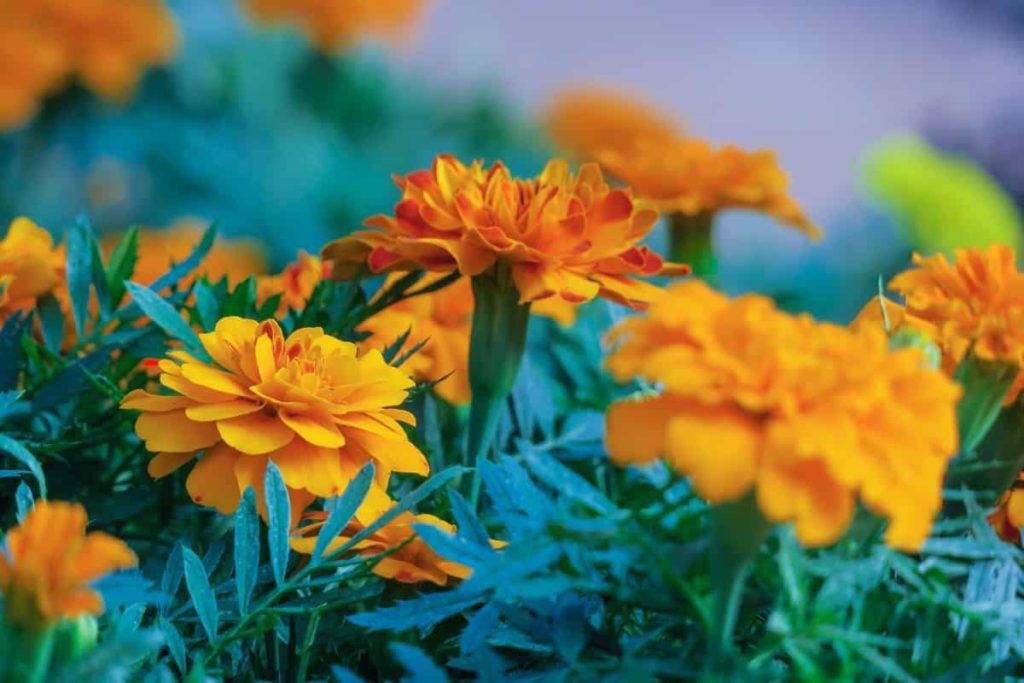Marigold is one of the most grown flowers for garden decoration and is widely used as loose flowers to make garlands for religious and social functions. Marigolds are beautiful garden plants for several reasons, including the ability to adapt to various soil conditions. They usually don’t mind which soil type they are grown in until it drains well. Let’s check out how to prepare the soil for Marigold plants below.

Heavy soil is not the only thing suitable for these plants. Holding on to the water, heavy soil will quickly rot the roots of your Marigold and prevent growth and flowers. You can try growing Marigold in light soil, but you should be very careful with water and rain to ensure that the soil is not filled with water and suffocating roots. Soil plays a crucial role in plant health. It significantly impacts the growth of the roots, without which the plant could not grow or survive on top of the soil.
Firstly, the soil has a certain amount of moisture depending on consistency. Water is very important for photosynthesis, so the roots need to flourish. Soil also contains specific nutrients made with water and carried around the plant. Without these nutrients, the plant will not survive. With only a few nutrients and others lacking, you will see major problems in your plant’s growth.
The soil type also controls how much oxygen reaches your plant’s roots, preventing suffocating. In short, soil type is important when growing any plant, including Marigolds. Nutrients are not a significant concern, as Marigold grows quite well in low nutrient soils if fertilizer is given an additional boost in the flowering season. They will grow and flower rapidly in rich soils, but moderate fertile soil is not a problem for these plants.
How to prepare the soil for Marigold plants
Soil pH for Marigold
Marigolds tolerate many different soil types and allow fluctuations in soil pHs. The best conditions for growing Marigolds include full sun and deep, fertile soil rich in organic matter. It is of utmost importance that your Marigold has well-drained soil. A mixture of sand or loam is excellent, as clay soil is too heavy for proper aeration and cuts the plant off from vital oxygen. Marigolds can grow and thrive when the pH is not ideal because they are not very sensitive plants.
Most species of Marigold grow best in slightly acidic soil with pH between 6.2 and 7, but don’t mind if conditions are slightly more acidic or alkaline. They usually don’t fuss until the pH drops below 5.5 or 7.5. There are a few options to make alkaline soil more acidic. Many gardeners add sulfur to the soil to reduce the pH faster. For a long-term solution, continue to modify soil with compost, which over time breaks down soil pH and improves microbe activity in the soil.
It is better to do a soil test before making any modifications to know how many products are added to produce the right pH. Excessive acidic soil causes health and development problems in the Marigold. Acidity in the soil is indicated by low pH. Do not allow your soil pH to drop below 5.8 while the Marigolds grow. The presence of iron and manganese increases when the soil becomes too acidic. Excessive use of iron and manganese in Marigolds causes a nutritional disorder called iron and manganese toxicity.
Preparation of soil for growing Marigold in pots
When it comes to growing Marigolds in containers, the rules are completely different. Depending on the nature of being in control, containers hold on to water, requiring large soil particles to remove all excess moisture through drainage holes. Use a pot full of soilless or seed-starting potting mix.
In case you missed it: 20 Common Marigold Plant Problems: How to Fix Them, Solutions, and Treatment

Soilless potting mix has materials like peat and bark. A handful of sand, perlite, or vermiculite improves drainage. Make sure there are drainage holes underneath the pot you are using. You want to place a board or plate under the pot to capture any excess water or soil from drainage holes.
Preparation of soil for growing Marigold on grounds
Marigold needs full sun and grows best in a well-drained, loamy soil. For best results, modify the soil before planting as per soil test results. The Marigold will likely not require additional fertilizer and will usually thrive with rich, well-drained soil and plenty of sunshine. A generous amount of organic or well-aged manure mixed in the garden before planting will greatly improve the health of flowers.
How to grow Marigold in poor soil
Marigold will not need any additional fertilizer unless your soil is extremely poor. Marigold can be sown outside in mild weather after the last frost passes and the soil heats up. Although Marigolds are tolerant of poor soil, they should be well-drained and modified with organic matter like manure.
Marigolds can grow in sandy soil when water is given more often to meet the immediate drainage. To improve drainage and aeration, you can modify clay soil by mixing a few inches down in river sand and manure to reach this consistency. Space Marigolds are two to three feet away, although low-growing species require only one foot of space.
In case you missed it: Growth Stages of Flowering Plants: Rose, Marigold, Hibiscus, Dahlia, Gerbera Daisy, and Jasmine

Symptoms of Marigold are in the wrong soil
Yellow leaves – Marigold leaves can be yellow for several reasons, most commonly in overwatered or waterlogged soil. Clay soils heavily hold water, leaving the roots permanently moist and oxygen not reaching the roots. If they start to soften and rot, your Marigold leaves may turn yellow. To prevent this problem, modify the soil with compost and sand before planting.
Wilting – The reason for the wilting could be both extremes, heavy clay soil or excessive sandy soil. Clay soil causes root rot that softens the stem and causes plants to wilt. Lack of moisture means that the plant’s cells do not have enough water to maintain structure and causes the Marigold not to reach its typical height, which also causes wilting. It is easy to modify with a healthy amount of compost before planting in sandy soil. Maintain soil health by adding a single layer of compost as a summer mulch to break down over time.
Brown leaves – Brown leaves indicate a more severe problem with sandy soil. Wilting is the first sign of dehydration; leaves gradually turn yellow and brown if the problem is not solved. It should not be a problem if you give enough water to your plants often. However, sandy soil drains very quickly and does not catch any water, leading to some leaves becoming brown. To prevent this, amends as much as possible with compost and water until conditions improve.
Discoloration – Yellow or brown spots on leaves or between veins usually indicate an insect or disease problem. However, they can also be caused by a lack of nutrients. Check the soil for nutrient deficiency before planting and add compost and related fertilizer to improve fertility.
Soil composting for Marigold
Since Marigold is a fast-growing crop, better root development and quality flowers require high doses of nitrogen and moderate levels of phosphorus and potash. Therefore, 40 to 50 tons per hectare of farmyard manure should be applied at the time of the preparation of land.
In addition to farmyard manure, it is advised to use 200 kg per hectare of nitrogen and 80 kg per hectare of phosphorus and potash for good flower production. A full dose of phosphorus and potash should be given before transplant, while nitrogen is given in two doses (30 and 60 days after transplant).
Land preparation for Marigold
Marigold grows best in loamy, well-drained soil. Sandy soil that traps water can prevent plant growth. To check if the garden soil is best for planting, dig a 12x 12-inch hole about 18 inches deep. Fill it with water, let it drain, and then do it over and over to see how long it takes to drain the water. The water level in the well-drained soil goes down by about an inch per hour.
In case you missed it: Best Fertilizer for Marigold: Organic, Homemade, Natural, NPK, and Compost Manure

Before planting the Marigolds outside, you’d like to weed out the site before planting. Also, make sure to clean any rock or debris. This makes the site more hospitable to Marigold plants so they can grow without interference. Hold the weeds as close as possible to the soil while taking the weeds. You want to remove the entire root part of the weed and the upper part of the ground; otherwise, the weeds will grow back.
You should prepare the ground by plowing 2 to 3 times, and 50 tonnes of well-rotten farmyard manure should be well mixed. Convenient-sized beds are built to facilitate irrigation and other cultural operations. Use a trowel or shovel to dig 8 to 10 inches in the soil. Turn it over to break the soil and make it airy. Do this for the entire area where you plant the seeds. When Marigold’s turning on the soil, make sure you break any clusters and remove any rock or pebble you find.
Best soil mix for Marigold
Marigold requires loam and well-drained soil. Before planting, mix organic vermin compost or dry manure in garden soil. This will boost Marigold’s health and provide the nutrients they need to thrive. Marigolds are not very picky in their soil, but you must ensure they are kept in moderately fertile and well-drained soil.
You should choose good quality soil that you can mix with some antifungal powder. You can add one tablespoon of dried mustard powder to the potting soil and sprinkle water on it. You can leave the mixed soil in a shady place for a few days.
Natural soil amendments for Marigold
Most plants respond well to amending the soil with organic matter. Compost is an excellent form of organic matter with a good balance of nutrients and an ideal pH level; you can add it to your planting area at any time. If compost is unavailable, top dress the soil after planting with 1 to 2 inches of organic mulch, which will start breaking into compost. After the growing season soil test will indicate what amendments are required in the soil for the next season.
Spread a pattern of organic mulch between Marigold plants, such as grass clippings, wooden chips, or bark, to help control nitrogen levels to prevent weeds. Decaying organic material adds a good number of micronutrients to the soil, improving drainage to avoid excessive moisture.
In case you missed it: Marigold Gardening For Beginners – Planting FAQs

Control weeds and young plants before the leaves become so large that soil shade is provided. You can carefully sprinkle your coffee grounds on the base of your plants without contacting any part of the plant. Allow rainwater to dissolve the grounds naturally, soak it in the soil and prepare it for new flowers. Worm activities can also help dissolve the grounds in the soil.
What to do with soil when growing Marigold
Marigold, as a companion plant in the vegetable garden, is also used to remove pests from vegetables and attract pests that will predate the pests. Sweet Alyssum is a flowery annual that can act as a ground cover at the base of your Marigold, helps prevent water loss, and serves as a living mulch. But providing ground cover is not the only purpose that Sweet Alyssum can offer.
Also, Sweet Alyssum attracts beneficial insects and predatory wasps that can help keep pest populations under control. White or purple color cultivars look especially beautiful with orange or yellow hues of Marigold orange or yellow. Cilantro makes a great companion plant in a garden or flower bed.
Its humble-shaped influence with small white flowers will attract beneficial wasps and aphid predators like ladybugs. If you are growing Cilantro to attract beneficial insects, choose a variety that is not described as slow to bolt. Those who produce flowers at the beginning of the season will start helping beneficial insects before.
In case you missed it: Growing Marigolds in Pots from Seed, Cuttings, Layering

Mixed plantations, including annual and chronic, consider the Allium family members to be plant partners in your garden ecosystem. Visually, Allium makes great companions. Garlic Chives, in particular, can help reduce the incidence of spider mite attacks. Kale and Marigolds are a great pairing when it comes to vegetable crops. When paired with yellow or orange Marigolds, the blue colors of the Kale look particularly attractive.
Marigold pairs well with Pumpkin. Pumpkin and other types of Winter Squash repel root-knot nematodes. Growing Tomatoes and Marigolds together has several benefits, and these two friends should be a regular couple in your summer garden. Planting Marigold companions increases the growth of Basil, Broccoli, Cucumber, Eggplant, Gourd, Kale, Potatoes, Squash, and Tomatoes. Marigold also makes a good companion plant for melons as it prevents beetles. Beans and Cabbage are bad companion plants for Marigolds.
Conclusion
The Marigolds are colorful and plants don’t fuss about many conditions, including soil. Marigolds have some essential requirements like soil type, pH, and fertility. Also, Marigolds offer many benefits and are incredibly favorable, and won’t give you much trouble. This article will help you with the soil needs of the Marigold, pH, and soil preparation, as well as the best soil for Marigold.
- How to Grow Hibiscus from Flower
- Plantation Ideas for Home Decoration: A Beginners Guide
- Flower Garden Designs and Layouts for Beginners
- Planting and Spacing Techniques in Papaya: A Beginner’s Guide
- Growing Gold: Essential Techniques for Planting Pineapples
- How to Make Kalanchoe Plant Bushy: Home Remedies and Solutions
- 11 Reasons Why Your Gardenia is Not Blooming: Home Remedies and Solutions
- Eco Elegance: The Guide to Designing a Drought-Tolerant Landscape
- Gardening on a Slope: Strategies for Hillside Landscaping
- Nourish and Flourish: Top Organic Mulches for Thriving House Plants
- Everything You Want to Know about Indian Mogra Flower: Discover Uses and Growing
- Green Thumb Success: Expert Tips for Cultivating Greenhouse Pumpkins All Year Round
- Maximize Growth & Flavor: The Ultimate Guide to Companion Planting in Herb Gardens
- How to Control Rhododendron Problems Naturally: Home Remedies and Organic Ways to Fix Them
- Natural Magic: The Remarkable Benefits of Cinnamon for Plants
- Best Steps to Revive Dying Tulip with Natural and Organic Treatment
- 10 Reasons Why Your Angel Trumpet is Not Blooming: Remedies and Treatment
- How to Fix Periwinkle Leaf and Flower-Related Problems: Natural Remedies and Solutions
- How to Fix Zinnias Leaf and Flower Problems: Discover Natural and Home Remedies
- Organic Steps to Induce Lemon Tree Flowers: A Comprehensive Guide
- Bloom Booster: Crafting the Perfect Homemade Bougainvillea Fertilizer
- Optimizing Growth: A Guide to Applying NPK Fertilizer for Potted Plants
- 10 Best Homemade Fertilizers for Rubber Plant: DIY Recipes and Application Method
- How to Boost Female Pumpkin Flowers: Effective Steps for More Flowers and High Yields
- Transform Your Indoor Garden: Top Benefits of Pink Salt for Houseplants
- 10 Best Homemade Fertilizers for Peacock Plants (Calathea): Easy DIY Guide
- Unlock Blooms: 9 Reasons Why Your Potted Chrysanthemum is Not Blooming
- 8 Reasons Why Your Potted Hibiscus is Not Blooming: Fix it with Simple Solutions
- Unlock Blooms: 9 Key Reasons Your Potted Frangipani Won’t Flower
- 10 Reasons Why Is My Ice Plant Not Blooming: Remedies and Treatment
- 10 Reasons Why My Potted Hydrangea Not Blooming: Treatment and Remedies
- 10 Reasons Why is My Wisteria Not Blooming: Remedies and Treatment
- 10 Reasons Why is My Goldfish Plant Not Blooming: Remedies and Treatment
- Maximize Your Space: Ultimate Guide to Balcony Gardening with Grow Bags
- 10 Reasons Why Your Iris is Not Blooming: Remedies and Treatment
- 10 Reasons Why Your Anthurium Plant is Not Blooming: Treatment and Remedies